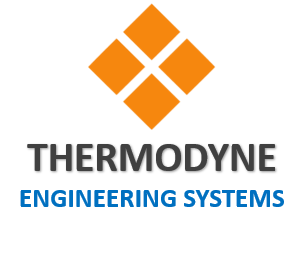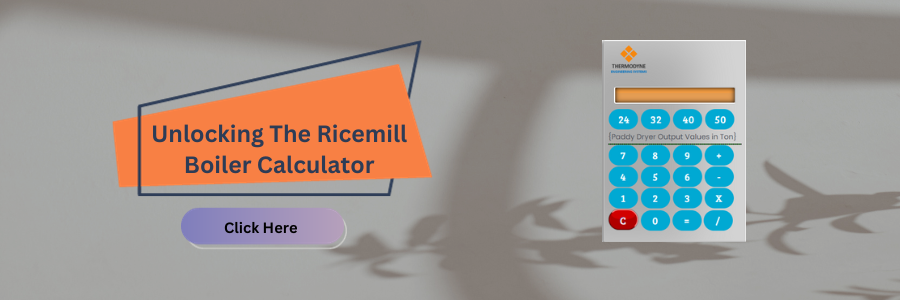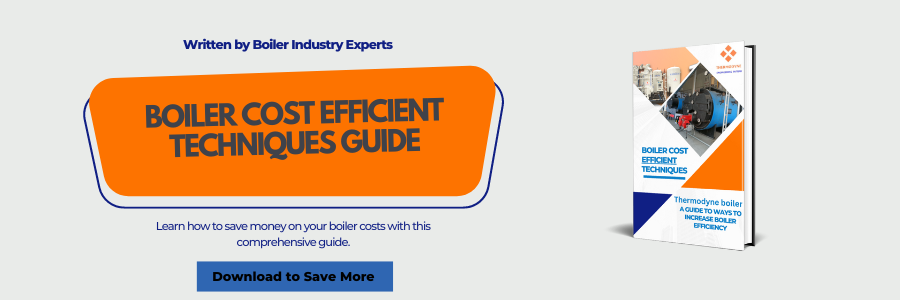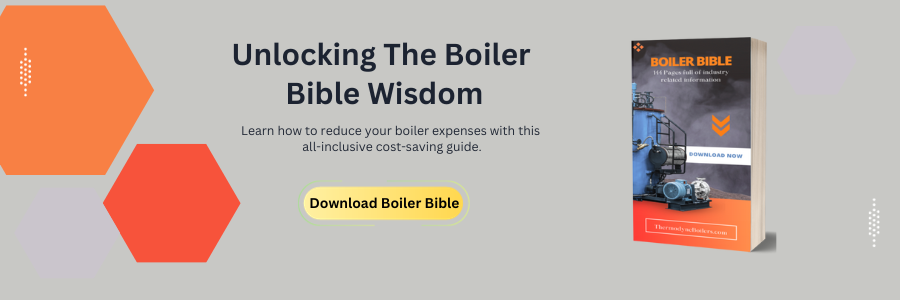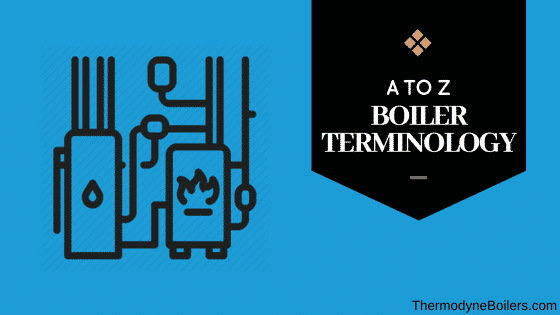
Table of Contents
Boiler Plant Terminology :
If you are connected to steam industry-education or employment or business- then this post is going to deliver a lot of value by adding lots of definitions and terms in your knowledge bank.
Today, We are going to Glossary of boiler terms related to steam process industry and steam boilers plants.
The following is a list of common keywords and words related to steam boiler plants- A-Z Boiler Terminology-
A
Accumulator
The boilers designed for average steam loads are not able to match the peak steam flow requirements here the Steam accumulators provide the buffer to take care of the process steam requirements very effectively.
Atmospheric Pressure
Pressure within the earth atmosphere generally denoted as 1 atm = 1.01325 Bar = 14.6959 Psi = 1.033 Kg/cm2. Atmospheric pressure decreases with an increase in elevation.
Absolute Pressure
It is the sum of pressure measured by a pressure gauge and atmospheric pressure. So, it is referenced from an absolute vacuum.
Asbestos rope
Asbestos has heat insulating properties and is generally used in an insulation process to tie the insulation on a pipe or for sealing the boiler.
Air Preheater (APH)
Air is required in a boiler for the combustion of fuel which is supplied by the Forced Draft Fan. Generally, fuel fed to a boiler contains some amount of moisture content in it which delays the burning of fuel. So to fasten the combustion process waste heat from the exhaust preheats the air entering the combustion chamber. This is done in an equipment called air preheater (APH).
B
Baffle
It is a restriction in the flow of fluid that serves 2 purposes: Firstly it creates turbulence in the path of fluid and increases the fluid velocity thereby increasing the rate of heat transfer. Secondly, it generates cross flow with respect to the tubes which helps in maximizing the heat transfer. They are generally installed in a shell side of heat exchangers.
Boiler
It’s an equipment which is used to boil water or convert water into a saturated steam at a required pressure. There are 3 types of boilers: Smoke Tube, Water Tube and Combi Boilers (Combination of water tube and smoke tube boilers).
Know more about the Function of Boiler
Blowdown
Feed water to the boiler generally contains impurities as well as TDS. As the TDS level of a boiler exceeds the set limit, one must get rid of the impure water by automatically or manually opening the blowdown valve at the bottom of the boiler shell.
Bag Filter
Bag filter is dust extraction equipment used to extract dust or ash particles from the exhaust gases. It consists of a long filter bags which have very small pores that allow only gases to pass through it and ash particles get to stick to the bags. They are around 99% efficient in extracting ash particles from the gases.
Burner
As the name defines burner is used for the combustion of liquid or gaseous fuels such as Light Diesel Oil, Heavy Diesel Oil, Natural Gas, LPG, etc.
C
Check Valve
Check valves are the type of valves that allow the flow of fluid in one direction only and thereby preventing the backflow of a fluid. These are generally used where the pressure down the line is high enough that there may be a possibility of backflow such as in case of a boiler feed line.
Combustion
Combustion is an exothermic chemical process that generates fire. On combustion, a large amount of radiation heat is released that converts water to steam in a furnace. Fire triangle consists of 3 basic requirements for combustion: Fuel, Oxygen, and Heat.
Combustion Chamber
It’s a part of a boiler either internal or external to the boiler where combustion of fuel takes place. Combustion of fuel generates a lot of heat so combustion chamber is generally made up of fire bricks when it is external to the boiler or made of steel when surrounded by water as in case of internal chambers.
Condensate
Steam generated by the boiler goes to a process where it is used for heating. During process heating, steam releases its latent heat and gets converted to water. This water is called condensate and has a high amount of sensible heat in it.
Condensate Recovery System –
In all the heating applications where steam heating is required, steam transfers its latent heat to form condensate. Condensate returning from the process is usually at a high temperature. The heat from the condensate can be recovered using a condensate recovery system.
Cyclonic dust collector
It’s a mechanical dust collector which works on the principle of density separation. Due to the high rotational velocity of gases during cyclonic motion, high-density coarse particles get separated from the gases and settles at the bottom. They are generally less efficient than Bag Filters.
D
Drum
Drum or generally called shell contains water, steam or mixture of both water and steam. In smoke tube boilers shell contains a mixture of both water and steam, water being denser forms the lower part of the shell while steam is above water level. In water tube boilers, water and steam can be filled in the same drum or separate drums.
Dust collector
All the equipment that is capable of extracting dust or as particles from the exhaust gases are called dust collectors. There are many types of dust collectors such as Cyclonic dust collector, Bag Filters, Electrostatic Precipitators, Scrubbers, etc.
E
External Fired Boilers
Boilers, where the furnace is located external to the shell, are called externally fired boilers. An external furnace is usually surrounded by the water wall tubes which accept most of the radiation heat from the combustion of fuel.
Electric Boiler
Boilers that use electricity to generate steam from water is called electric boilers. They use electrodes that are a good conductor of electricity, as soon as the water comes in contact with the electrodes a large amount of heat is generated that converts water to steam.
Electrodes
F
Fuel
TFuel is any substance that reacts with Air in presence of heat to generate fire. This is called combustion of fuel. Basic examples of fuel used in boiler industries are, Solid fuels such as: Biomass wood, Animal and plant waste, Coal, Petcoke, Rice Husk, Bagasse, Sawdust, Briquettes, Liquid fuels such as: Light Diesel Oil, Heavy Oils, Furnace Oil, Gaseous fuels such as Natural Gas, Liquefied Petroleum gas, etc.
Flue Gases
Fuel gases or smoke is a product of combustion of fuel or reaction of the fuel with air. Fuel which is generally a mixture of carbon, sulfur, hydrogen, and moisture reacts with air to give carbon dioxide, carbon monoxide, sulfur dioxide, water vapor etc. All these gases combined are termed as flue gases.
Feed Water Line
This is the pipeline through which the water is fed to the boiler from the feed water tank with the help of a pump.
G
Gaskets
Gaskets are generally the round steel material used between the flanges. Whenever there is a flanged joint between the piping, the gaskets are fitted between the flanges to prevent any leakages from the joints. Gaskets generally tighten the joints so that the leakages can be minimized.
H
Heat Capacity
Amount of heat that can be stored in a fluid per unit mass and per unit temperature is termed as heat capacity. Heat capacity is generally measured in Kcal/Kg/0C or J/g/K.
I
Induced Draft Fan
Induced Draft Fan or ID Fan is installed to draw out the hot gases from the system by developing negative pressure at its inlet. It is generally installed at the end of the process to prevent any back pressure thereby improving the system efficiency.
L
Limit Switch
These are devices which are used to measure the pressure at a point referencing the atmospheric pressure, a difference of pressure of fluid flowing in a pipe at two different positions.
M
Manometers
These are devices which are used to measure the pressure at a point referencing the atmospheric pressure, the difference of pressure of fluid flowing in a pipe at two different positions.
N
Nucleate Boiling
As the name itself clarifies that this is the term relating to the type of boiling which referred as when the temperature of the heating surface is much more than the feed water, doing so the bubble formation start in a larger amount and these bubbles try to escape rapidly to free surface which turns the faster evaporation of water.
NRV
Non-return valve, this is one of a type of valves which allows an only unidirectional flow of the fluids.
NCV
Net calorific value, this is the energy stored in the fuel in the form of the chemical composition also can be referred to as the internal energy of the fuel in storage.
O
Optimizer
This is the device which is used in the coil type boiler to increase the temperature of the water before feeding that it into economizer.
P
Pressure
This is the main parameter for designing the boiler. there may be three kind of pressure relating to boiler industries i.e. Design pressure, Working pressure & Hydraulic Pressure
Pressure Reducing Valve
As the name itself clarifies it is a type of valve which is used to reduce the pressure of the steam as per requirement different types of sizes are available for the same
Pressure Reducing Station
As the name itself clarifies, it is a type of system which is used to reduce the pressure of the steam as per requirement for different processes at the same time doing so the no. of branches of steam connections are provided at different pressure and quantity of steam as per requirement.
R
Rotary Feeder
The main work of a Rotary Feeder is to feed Fuel into the Furnace of a boiler. this equipment comes under the category of material handling equipment.
Rotary Valve
The main work of a Rotary valve is to remove the ash automatically in a periodic time from the dust extraction systems like Dust collectors, Wet Scrubbers, Bag Filters, Ash hopers of Furnaces, etc.
S
Safety Valve
This comes under the boiler mountings & Fittings. it’s work is to release the excess steam which is causing an increase in pressure above working pressure. as per the Indian Boiler Regulation, the Quantity must be at least Two for Ensuring the safety of human beings.
Single Dust Collector (SDC)
The main work of an SDC is to remove dust particles from the flue gases by providing cyclonic motion to the flue gases inside a cyclonic shaped part of an SDC. as these dust particles may create problems in the working of an ID Fan & these dust particles also spread the pollution in our environment.
Steam Distributor Header
This is a header Pipe which is used as a Distributor of Steam as per different Quantity of steam at the different pressure required in processes.
T
Twin Dust Collector (TDC)
The main work of a TDC is to remove dust particles from the flue gases by providing double cyclonic motion in two different cyclone parts of this TDC. As these dust particles may create problems in the working of an ID Fan & these dust particles also spread the pollution in our environment.
Total Dissolved Salts (TDS)
This is the parameter to analyze whether the water which is to be fed into the boiler will not cause any problem like boiler inside layer corrosion, scale formation, sludge formation, etc.
U
Ultimate Tensile Strength (UTS)
This is the parameter to analyze whether the design is safe for a particular pressure and temperature for which the boiler is designed.
V
Viscosity
It can be simply defined as the thickness of water. this is the term which shows how easily the fluid (say water) can flow through the pump to be fed into boiler if the Viscosity of water is more, then it becomes difficult for a pump to feed the water into the boiler.
W
Working Pressure
This is generally defined as the design pressure on which the boiler works normally. The working pressure inside the boiler must not exceed above the design pressure.
Waste Heat
This is the heat liberated from the flue gases at the exhaust of boilers or furnace kilns. These are the gases which are exhausted directly into the atmosphere from the furnaces & chimney thereby causing direct heat losses.
Waste Heat Recovery Boiler
As we are aware of the heat liberated with the Flue gases is exhausted directly into the atmosphere this waste heat can be utilized by our specially designed boiler known as Waste Heat Recovery Boiler(WHRB) & depending upon the quantity & temp of flue gases the size of the WHRB is decided so as the output Energy.
Water Tube Boiler
Water tube boilers come under the category of the High-pressure boiler which is mainly designed for the power generation stations. In water tube boilers, water and steam mixture is inside the tubes while flue gases or smoke flow across the tubes.
Wet Scrubber
Wet scrubbers are used in boilers as boiler accessories to control the pollution of the environment. The main work of a wet scrubber is to remove the sulfur contents and as well as the small dust particles which were not separated by dust collectors.
Feed Waterline
This is the pipeline through which the water is fed to the boiler from the feed water tank with the help of a pump.
X
X-Ray Detection
X-Ray test is used to identify the fractures inside the weld joints after the welding process. This test is used where the fractures are not visible through the naked eyes. This process ensures the safe boiler operation as the weak weld joints may get worse at the time of operation.
Y
Yield Strength
This is the parameter to analyze whether the design is safe for a particular pressure and temperature for which the boiler is designed & to ensure its satisfactory working. This is an important parameter because it directly relates to the safe boiler operations.
Z
Zeolite
A zeolite is a group of minerals consisting of hydrated aluminosilicates of sodium, potassium, calcium, and barium. It is used as cation exchangers and molecular sieves to remove the hardness of feed water to a boiler (i.e., removing minerals from water).
There are three main types of industrial steam boilers: fire-tube boilers, water-tube boilers, and packaged boilers. Fire-tube boilers have a firebox that heats tubes that carry water. Water-tube boilers have tubes that carry water that are surrounded by a firebox. Packaged boilers are pre-fabricated boilers that are easy to install and maintain.
An industrial steam boiler is a closed vessel in which water is heated to produce steam. The steam is then used for a variety of purposes, such as heating, power generation, and manufacturing.
The main components of an industrial steam boiler are the firebox, the water tubes, the steam drum, the superheater, the economizer, and the flue gas ducting. The firebox is where the fuel is burned to heat the water. The water tubes carry the water from the firebox to the steam drum. The steam drum is where the steam is generated and collected. The superheater heats the steam to a higher temperature. The economizer preheats the water before it enters the firebox. The flue gas ducting carries the hot flue gases from the firebox to the stack.
Industrial steam boilers work by using heat to convert water into steam. The heat is typically generated by burning fuel, such as oil, gas, or coal. The water is heated in the firebox and then circulated through the water tubes. The steam is then collected in the steam drum and can be used for a variety of purposes.
Industrial steam boilers offer a number of benefits, including:
They can provide a large amount of heat.
They are efficient and can save energy.
They are reliable and can operate for long periods of time.
They are easy to maintain.
Industrial steam boilers have a few drawbacks, including:
They can be expensive to purchase and install.
They require a lot of space.
They can be dangerous if not properly operated and maintained.
When choosing an industrial steam boiler, you need to consider a number of factors, including:
The amount of heat you need.
The type of fuel you will use.
The size of the boiler.
The cost of the boiler.
The ease of maintenance.
Industrial steam boilers should be installed and maintained by qualified professionals. The installation process will vary depending on the type of boiler you choose. The maintenance process will involve regular inspections and cleaning, as well as repairs as needed.
There are a number of safety precautions you need to take when using an industrial steam boiler, including:
Always follow the manufacturer’s instructions.
Never overload the boiler.
Keep the boiler clean and free of debris.
Inspect the boiler regularly for leaks and damage.
Never operate the boiler if it is damaged.
You can get more information about industrial steam boilers from a number of sources, including:
The manufacturer’s website.
Trade publications.
Professional organizations.
Government agencies.
